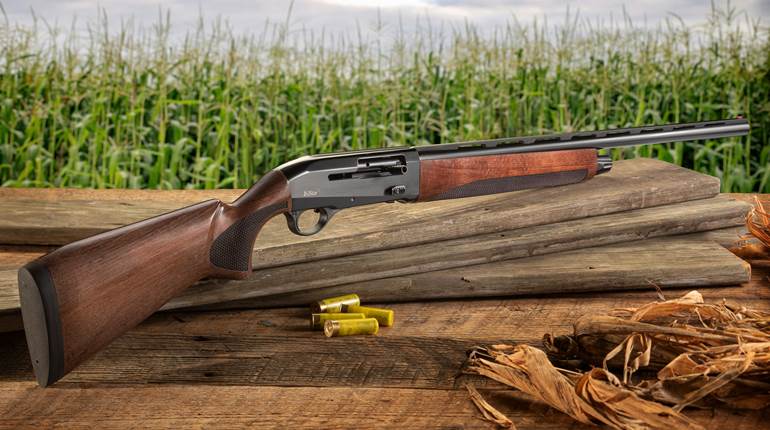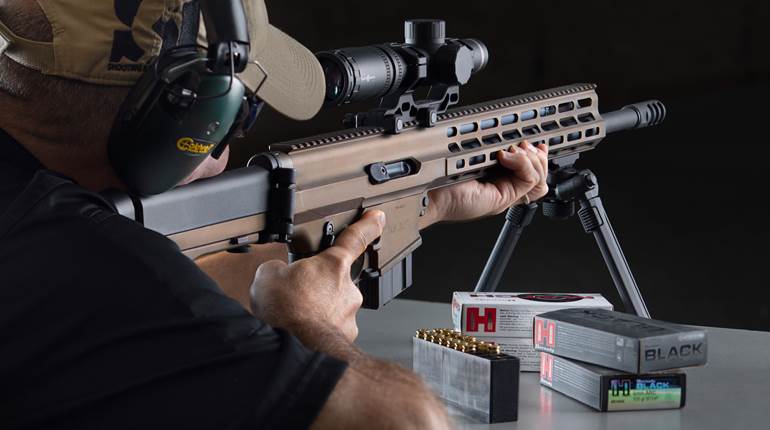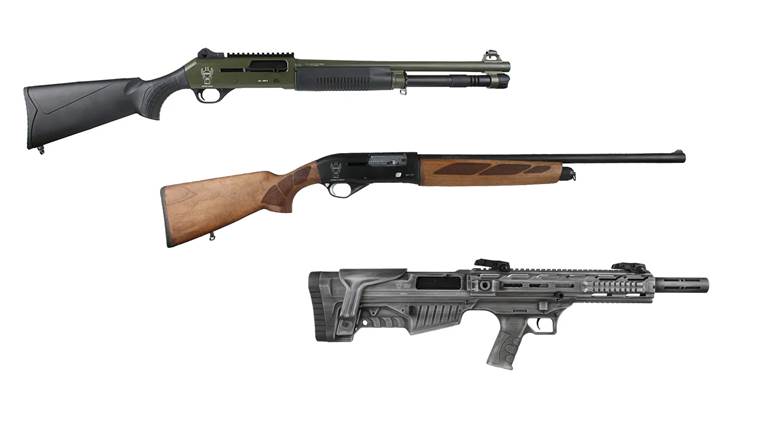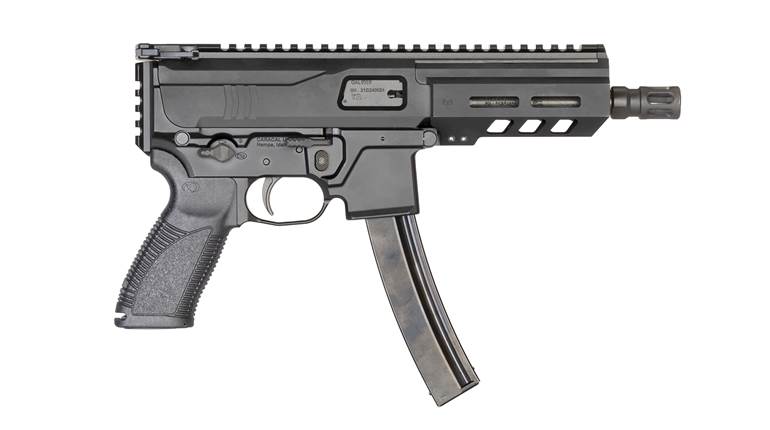
Introduction
Shotguns are very effective arms for home defense, because their power far eclipses most handgun and many rifle rounds. A typical self-defense load, the 12-ga. 00 buckshot shell, has a muzzle energy 2.8 times that of a .44 Mag. from a 6” handgun barrel and 1.8 times that of the 5.56 NATO cartridge used by AR-15s, loaded with a 69-gr. bullet. Yes, shotguns loaded with anything but slugs have a very limited effective range, but they certainly hold sway at home-defense distances when using the proper loads.
Shotguns also come with several downsides, which include limited ammo capacity, heavy recoil, slow reloading and a manual of arms that is not intuitive and also lacks commonality with the AR-15. Though some shotguns have detachable box magazines and AR-15 styled controls that mitigate these deficiencies, they don’t match the reliability of a tube-fed gun, which is designed to feed blunt-nosed shot shells.
Running a tube-fed shotgun proficiently requires more skill than a pistol, but because the shotgun’s tactical prevalence has been overshadowed by the AR-15, shotgun training is somewhat scarce. The Defensive Shotgun Course given by Tom Givens of Rangemaster Firearms Training, however, is one way to get a solid foundation in tactical shotgun shooting. I recently took this class using a Benelli M4. First we'll address the class, then look at the M4 and how it performs.
Rangemaster Defensive Shotgun Course
This class teaches tactical shotgun shooting basics in the context of defending your home or business. It’s not for three-gun competitors, nor law enforcement or military operators, or for those who carry shotguns as “trunk guns,” where the dynamics of an anticipated armed encounter are far more variable. The ideal student is someone who bought a shotgun for self-defense but knows little of its capabilities or how it should be equipped and deployed. That is, beyond Hollywood-inspired fallacies.
The one-day course starts in the classroom, and covers a good deal of essential shotgun material and some interesting historical uses of the tactical shotgun, shotgun myths and the proper defensive loads to use along with those to avoid. Givens’ enthusiasm for shotguns is obvious, and he clearly prefers them over handguns and AR-15s for home defense. He states that a solid hit with a 00 buckshot load will assuredly stop a threat, or in his words, “if they get shot with a shotgun, they stay shot.”
Givens also explains his recommended shotgun configurations and the rationale behind his choices. He prefers traditional stocks over pistol grip designs, a short length of pull, a gun mounted ammo carrier, iron sights instead of red dots and extended magazine tubes, provided they don’t involve barrel clamps.
Slings are eschewed as inviting entanglements and takeaways by your opponent when moving through your home, and flashlights hurt maneuverability by adding weight up front and are unnecessary for home defense when you can turn on the lights. Also covered are replacement parts and modifications that improve shotgun function, along with a warning about those that do the opposite.
The afternoon consists of range time with dry- and live-fire exercises. The drills are very basic and mostly conducted at the six-yard line. He emphasizes the importance of aiming each shot, even at that distance, immediately cycling your pump gun after firing and always keeping the gun fully loaded using ammo plucked from your receiver or buttstock mounted shell carrier.
The Importance of Patterning your shotgun
For many students, the most enlightening takeaway was the patterning demonstration that showed how different types of shotshells produce widely different pellet spread. Patterning your gun and load is absolutely critical because you need to know which shots can be safely taken at a given distance. Givens cautions that erratic shot pellets can easily become a liability.
Barrel and ammo design affects shot patterns, and he explains the three ammo-related reasons: shot hardness, buffering to cushion the pellets and wad design. His favorite 12-ga. defensive round is the Federal Flight Control 2 3/4” shell loaded with copper-plated 00 buckshot, buffering and a special wad. I’ve also used this load, and it typically delivers dense, evenly distributed patterns which increases your potential engagement distance as a result.
The Benelli M4
Benelli’s M4 is the civilian version of the 12-ga. M1014 semi automatic shotgun, which was adopted by the Marine Corps in 1998. The M4 accepts 2 3/4" or 3” shells, and uses a short-stroke, gas-piston system that requires a load with a minimum 3-dram equivalent powder charge and 1 1/8 ozs. of shot to operate reliably. That load is common and affordable for practice and plinking sessions.
The magazine holds five rounds. The 18.5” chrome-lined steel barrel has a Parkerized finish, and comes with a modified choke. As for the M4's receiver, it is made of machined aluminum. It is available with a traditional or pistol-grip buttstock.
 The Benelli M4 fully field stripped.
The Benelli M4 fully field stripped.
The M4 offers two distinct operational advantages over some other shotguns. First, the trigger-blocking, cross-bolt safety can be applied even if the hammer is de-cocked. Second, the action can be opened to eject an unfired shell without causing fresh shells to be fed onto the shell carrier from the magazine tube. Like the magazine cut-off switch found on the Browning Auto 5, this feature allows you to quickly switch from a buckshot load to a rifled slug, a capability that matters most when you encounter a target at a distance, where a slug would be required. Remington, Mossberg and FN Herstal tube-fed shotguns don’t allow a chamber-shell switch as easily.
A Modified M1014
Because the M4 is Italian made, it needs to comply with a section of the 1968 Gun Control Act that gives the ATF the authority to ban imports that are not “particularly suitable for or readily adaptable to sporting purposes”. That means that the M4 can’t be imported with a collapsible buttstock or a magazine holding more than 5 shells.
However, you can legally configure an M4 like an M1014 with its 7 shot mag and collapsible stock by substituting 3-4 U.S made parts in place of the Italian-made parts selected from a specific ATF parts list. Unhappily, it’s not a simple task because the 5 shot magazine tube is secured to the receiver with permanent Loctite.
ARGO Gas Operating System
The M4 uses Benelli’s ARGO system. Durable and simple, the ARGO system uses two stainless-steel piston rods, each with a separate gas port and gas block. It requires no adjustment, is self-cleaning and does not have "O" rings to wear out. The piston rods directly impact the bolt carrier without additional linkage. Both gas ports are located just ahead of the chamber, which makes the system comparatively short. The ARGO system was also used in Benelli’s short-lived MR1 rifle, and a slightly modified version is used on the R1 rifle.
 The detached barrel section of the Benelli M4, showing the two gas blocks and piston rods of the Benelli ARGO gas system.
The detached barrel section of the Benelli M4, showing the two gas blocks and piston rods of the Benelli ARGO gas system.
Superb Sights
Among the best features of the M4 are its sturdy aperture sights that help you deliver quick, accurate shots, something proven time and again during firing drills in Givens’ class. The front is a protected post with a white dot while the rear is a protected ghost ring. The front is drift adjustable for windage while the rear is fully adjustable using two set screws.
 A view of the protected, adjustable, rear-sight that comes standard on the Benelli M4, along with the Mesa Tactical side-saddle shell carrier and Trijicon MRO mounted to the Picatinny rail.
A view of the protected, adjustable, rear-sight that comes standard on the Benelli M4, along with the Mesa Tactical side-saddle shell carrier and Trijicon MRO mounted to the Picatinny rail.
The M4 has a Picatinny-style receiver rail for mounting an optical sight. However, I replaced it with the Mesa Tactical eight-shell capacity side-saddle shell carrier, which has an integral rail. The Mesa shell carrier is of high quality, made from aluminum that attaches to the receiver in place of the existing rail. It also has means to adjust shell holding tension, which makes a big difference in reloading speed by changing a rubber insert, two of which are included.
Range Time
The Benelli is an expensive, well made shotgun that functioned perfectly with several brands of slugs, buckshot and 3-dram equivalent birdshot loads. Shells feed easily into the magazine tube without the shell lifter catching my thumb as other guns tend to do, and the action cycles smoothly without even a hint of grittiness, no doubt because of the finer machining of parts and a chrome plated bolt.
 The bolt of the Benelli M4 fully disassembled.
The bolt of the Benelli M4 fully disassembled.
The trigger guard is thick and made of aluminum. The only plastic parts used are the buttstock, grip and hand-guard. This shotgun has other subtle features that underscore better engineering and construction quality, which become apparent with a side-by-side comparison to a competitive shotgun. The M4’s choke wrench, with an integral thread chaser to keep the fine barrel threads clean, is but one example that compares favorably to the typical stamped steel wrenches, which have no such provision.
The M4 is intended to be a faithful recreation of the M1014, which met the requirements of the U.S. military over two decades ago. Yet its ergonomics could be improved to contemporary standards by switching to a larger safety and bolt catch, enhancements Benelli made to its competition shotguns. A larger bolt catch in particular would make for faster chamber reloading, where the support hand reaches around the receiver to close the action.
The M4 I used has a pistol-grip stock, but I prefer the traditional style for most uses. The pistol-grip stock requires a change in firing grip to activate the cross-bolt safety, and slows down reloading using the support hand, something three-gun competition shooters know and a reason they don’t use them. The pistol-grip stock, however, is superior to the traditional style when standing with the gun slung from the shoulder and pointed down, a stance used by sentry guards.
A shorter buttstock would improve the M4’s handling and maneuverability. A 14.37” length-of-pull makes it 40” long, or 2.2” longer than Beretta’s 1301 Tactical shotgun, which has an identical barrel length.
Buckshot and Slugs Test Results
Shot pattern results on a 12” circular target shot at 25 yards using Hornady Critical Defense 00 buckshot are shown in the accompanying table. The 12” diameter target represents a hit on a threat while the inner 8” circle is intended to be a more effective core shot. It’s not a perfect scoring system, but it demonstrates the capabilities of your shotgun using a particular load. Here, the M4 put 92 percent of the pellets on target at 25 yards, but eight percent, on average, were misses, and potentially a liability. Thus, closer targets may be advisable depending on the defensive situation encountered.
 Hornady American Whitetail rifled slugs and Critical Defense 00 buckshot used in testing the Benelli M4 for accuracy potential.
Hornady American Whitetail rifled slugs and Critical Defense 00 buckshot used in testing the Benelli M4 for accuracy potential.
I also conducted a limited test of the M4 at 50 yards with Hornady American Whitetail Rifled slugs, using a Trijicon MRO sight and shooting off a Caldwell rest. The average size of four, five-shot slug groups was 3.1”. However, two of the four groups had a flier. Without this flier, all four groups would have measured a respectable 2”.
 Results from testing the Hornady American Whitetail rifled slugs through the Benelli M4 at 50 yards.
Results from testing the Hornady American Whitetail rifled slugs through the Benelli M4 at 50 yards.
Pattern Results: Average of 10 Shots at 25 Yards (% of Pellets)
|
|
8” Inner Circle |
12” Outer Circle |
Total on Target |
Off Target |
Velocity FPS |
|
Hornady Critical Defense 2 ¾”, eight-pellet 00 buckshot |
31% |
61% |
92% |
8% |
1,462 |
Velocity measured 10’ from the muzzle with an Oehler 35 chronograph at 88º F.
Accuracy Results: Four, Five-Shot Groups at 50 Yards
|
|
Smallest |
Largest |
Average |
Velocity FPS |
|
Hornady American Whitetail 2 ¾”, 1-oz. slug |
2.0" |
4.5" |
3.1" |
1,439 |
Velocity measured 10’ from the muzzle with an Oehler 35 chronograph at 88º F. Group size measured in inches.
Specifications
|
Gauge: |
12-ga., 2 ¾” to 3” |
|
Barrel: |
18.5” |
|
Length: |
40” |
|
Weight: |
7.8 lbs., unloaded |
|
Sights: |
adjustable aperture |
|
Stocks: |
polymer |
|
Action: |
semi-automatic |
|
Capacity: |
5+1 |
|
MSRP: |
$1,999 |
Benelli USA
17601 Indian Head Hwy.
Accokeek, Md. 20607
(301) 283-6981






































